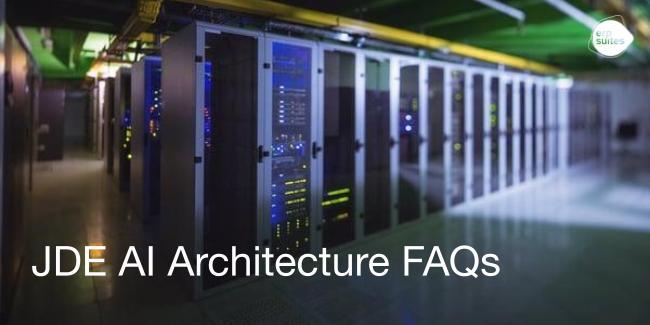How to Eliminate Manual Tasks in JD Edwards with OCI
June 17th, 2025
3 min read
In this episode of "Not Your Grandpa’s JD Edwards," Nate Bushfield welcomes Frank Jordan, Director of JD Edwards Technology at ERP Suites, to explore how Oracle Cloud Infrastructure (OCI) combined with JD Edwards orchestrations can significantly automate tedious manual tasks. Frank shares real-world success stories, illustrates how businesses can practically leverage OCI services, and explains why embracing automation is crucial for efficiency and productivity. By the end of the episode, you'll have actionable insights on how orchestrations and OCI services can dramatically enhance your business operations.
Table of Contents
-
Introduction: Automation Opportunities in JD Edwards
-
Common Challenges with Manual Processes
-
When to Consider OCI Automation
-
Impacts of Manual Inefficiencies on User Morale
-
Practical First Steps for OCI Integration
-
Essentials for Successful OCI Integration
-
Real-world Success Stories
-
OCI Document Understanding and OCI Vision Use Cases
-
Final Advice: Taking Action on Automation
Transcript:
Introduction: Automation Opportunities in JD Edwards
Are your JD Edwards users bogged down with tedious manual tasks that drain productivity? What if your business could automate these processes seamlessly using advanced AI and cloud infrastructure?
Today, I'm joined by Frank Jordan from ERP Suites to reveal how you can integrate JD Edwards orchestrations with Oracle Cloud Infrastructure services to eliminate manual data entry and significantly boost efficiency.
Frank, great to have you—how are you today?
I'm fine, Nate. Thanks for having me.
Common Challenges with Manual Processes
Frank, let's dive right in. Why do so many JD Edwards users still struggle with repetitive manual tasks?
Over the years, JD Edwards evolved significantly, but many tasks remain manual. Orchestrations, introduced about 10 years ago, have transformed automation by separating the user interface from business logic. Yet, companies often struggle with knowing where to start. The answer: start simple. Automate repetitive tasks first and build from there.
When to Consider OCI Automation
What signs indicate a company should explore automation through OCI services?
OCI offers powerful cloud services that complement JD Edwards orchestrations. If you're seeing repetitive manual tasks, frequent errors, or delays—those are clear signs. OCI provides tools like AI-driven document understanding, infrastructure automation, and much more to address these inefficiencies.
Impacts of Manual Inefficiencies on User Morale
How do manual inefficiencies affect user morale and business performance?
Repetitive tasks demoralize employees. Automating these tasks through orchestrations can improve job satisfaction, reduce human error significantly, and boost overall productivity. One client reduced journal entry errors dramatically from hundreds per month to just one or two, boosting morale and operational efficiency significantly.
Practical First Steps for OCI Integration
Once a company identifies automation needs, what's the next practical step?
Start with small, manageable wins. Update to the latest JD Edwards release, if necessary, to take advantage of orchestrations and OCI services. Then tackle one small task—such as automating data entry. Once you experience success, your team gains momentum, making larger-scale automation achievable.
Essentials for Successful OCI Integration
What essentials must be in place to integrate orchestrations effectively with OCI?
Essential prerequisites include upgrading to JD Edwards Tools Release 9.2.8.2 or later. You also need to establish secure OCI tenant accounts and API keys. Ensuring these basics are set up correctly creates a secure foundation for seamless integration between orchestrations and OCI services.
Real-world Success Stories
Could you share some specific success stories using orchestrations integrated with OCI?
Absolutely. One example involved automating server provisioning with orchestrations, significantly accelerating deployment times. Another company leveraged OCI’s document understanding service to automate vendor onboarding. Instead of manual data entry, orchestrations pulled data directly from vendor forms, cutting down onboarding from hours to mere minutes.
OCI Document Understanding and OCI Vision Use Cases
Let's dig deeper into OCI Document Understanding and OCI Vision. How exactly are these services streamlining daily operations?
OCI Vision excels at quality control—automatically identifying defective products, thus streamlining manufacturing processes. OCI Document Understanding significantly reduces manual data entry, automatically extracting data from PDFs, contracts, and forms, then directly updating JD Edwards tables, drastically reducing errors and improving speed.
Final Advice: Taking Action on Automation
Frank, any final advice for listeners looking to get started?
Start small—take baby steps. Use orchestrations and OCI for quick wins to build internal confidence. OCI services combined with orchestrations are powerful, scalable, and can significantly enhance your productivity. The important part is simply to begin your automation journey.
Next Steps
If you're ready to eliminate manual tasks and significantly boost your JD Edwards efficiency, visit ERPSuites.com or connect directly with Frank Jordan and his team. ERP Suites can help you quickly achieve measurable automation outcomes.
That’s a wrap on today's episode of "Not Your Grandpa's JD Edwards." Huge thanks to Frank Jordan for sharing his expertise. If you found value in today's discussion, subscribe, leave us a review, and share with your colleagues looking to move beyond manual processes.
Until next time, keep automating, keep innovating, and keep pushing JD Edwards forward!
Video Strategist at ERP Suites
Topics:


